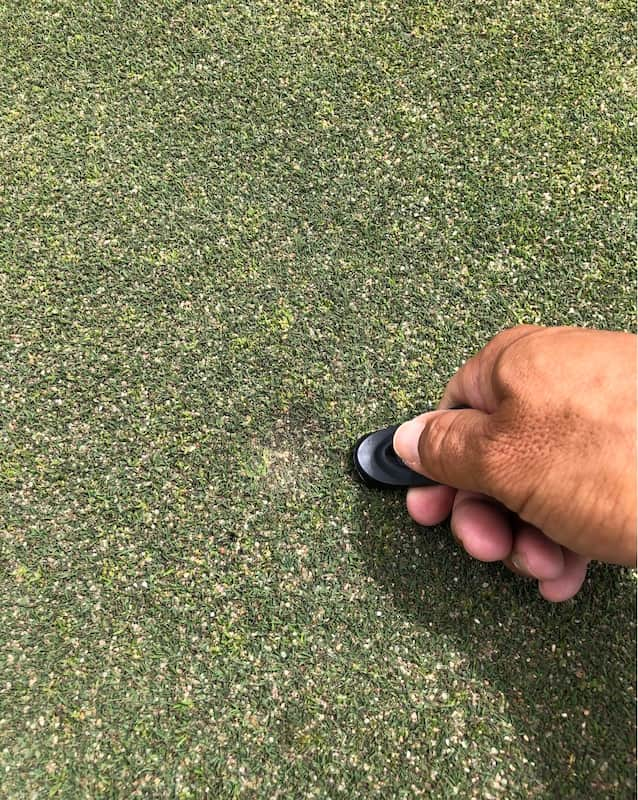Ball marks are indentations on the putting green after your golf ball lands on it. But what’s important to know is that this area is salvageable and should be repaired upon arrival.
It’s the courteous thing to do in the gentlemanly game of golf. Leave the course the same way you arrived. It’s good for the green conditions and it’s also courteous for the players behind you.
In addition to common courtesy to the players behind me, I know that if I don’t immediately repair the ball mark, it could take over a week for the grass area to repair itself (the indentation will be there forever if nobody fixes it).
When I was the Head Golf Professional in Illinois, I managed the course like I was the owner so I treated every inch of it as my own. I would fix every ball mark on the green as I walked passed them (whether I created them or not) and fill every divot that I passed in the fairways. And as the Course Head Pro, I wasn’t about to let all the effort our maintenance staff puts into the course go to waste!
I do this on every golf course I play, regardless of whether or not I have an affiliation with them.
Fix Ball Marks Immediately
Fixing ball marks is like fixing divots: repairing them as soon as they happen will give them the best chance at repairing immediately. In fact, ball marks on greens, if repaired properly, won’t need any time to repair and you will never know that they were even there.
It can take up to almost a month if a ball mark is not fixed immediately afterwards. However, if you properly repair it right after it was made, it would be like it never happened.
Common Golf Courtesy
Remember: Golf is a gentleman’s game. So it’s common courtesy to address any imperfections you give the course. Others may see you and may get inspired to do the same. My brother and all my assistants now do this when they play. We even fix the ball marks that aren’t ours. Spread the love and our balls will roll on the green more smoothly!
So let me teach you how best to repair ball marks on a green so no one will ever know you made them…
Repairing Ball Marks
These little craters into the green or even the fringes can wreak havoc when not fixed immediately and properly. You and other golfers can see a green with spots all over which means the greens are not as smooth as it should be.
Also note that if you were to repair it incorrectly, it is more damaging if you were to leave it alone. It’s recommended to use a ball mark repair tool (a small pronged tool). Let’s learn how to fix them properly and always fix yours and any you see because you can make a difference and will be noticed by the Golf Gods.
- Always start at the back outer part of where the ball came in from. You may notice the grass pushed back like a rug so insert a repair tool just on the outside of it and push towards the center. This will move the grass back to the center of the mark.
- Go around the mark and do the same pushing the top of the tool towards the center of the mark. You can also gently twist it towards the center also. The goal is to get the grass spread out over the mark.
- Use your putter to gently tap down on the mark to smooth it out.
Types of Ball Marks
The type of indentation depends on the angle your ball lands, the speed of the ball, the spin of the ball, and the slope and firmness of the green. There are several types of ball marks that can occur on a green:
- Pitch Marks: Pitch marks are the most common type of ball mark on a green. They occur when a golf ball lands on the green with a steep angle of descent, creating a small depression. Pitch marks can be easily identified as a small indentation where the ball has struck the green.
- Skid Marks: Skid marks happen when the ball lands on the green and slides or skids across the surface before coming to a stop. These marks are usually longer and shallower than pitch marks and can sometimes be mistaken for spike marks (indentations left by golf shoes).
- Bounce Marks: Bounce marks occur when the ball lands with a shallow angle of descent and bounces once or multiple times before settling on the green. These marks are often small and can be less pronounced than pitch marks.
- Plug Marks: Plug marks, also known as ball plug marks or ball marks, happen when a ball lands on the green with enough force to embed a small piece of the green’s surface into the depression. This type of mark can be more challenging to repair due to the embedded nature of the turf.
- Deep Crater Marks: Deep crater marks result from a ball landing with a significant amount of force and digging into the green, creating a relatively large and deep depression. These marks can be particularly disruptive to putting lines.
- Spike Marks: While not caused by a golf ball, spike marks are indentations left by golf shoes, particularly the metal spikes that were more commonly used in the past. Modern golf shoes often have soft or replaceable spikes to minimize this type of damage.
Never Push Up with the Repair Tool
Never lift with your repair tool to fix a ball mark because pulling up the roots can kill the grass on the spot. I have even seen some Professional players on Tour repair their marks incorrectly as their concern is to smooth it out as quickly as possible, so please do not mimic this procedure. Everything else they do however, you should mimic.


